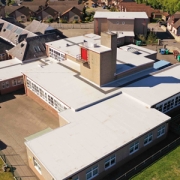LIQUID SOLUTION: Trusted partners ensure schools trust is free from worry with flat roof refurbishment.
Desire to deliver a safe learning environment for the children in its care prompted Knowledge School Trust to address the crucial upgrading of the roofs at West London Free School.
The school delivers education for primary and secondary pupils across two sites in Hammersmith. Both estates had roofs at least 30 years old, which had outlived their serviceable life, receiving yearly significant ongoing patch repairs. Water was penetrating through the woodwool slab and asphalt into the building fabric causing structural deterioration, leaking into classrooms, creating mould. Aged rooflights had become fragile. The thermal U-value for the roofs at the primary school was extremely poor and possibly contributing to heating costs the school sites incurred.
To strip the roof back to the decking would have been impractical due to the significant amount of roof-mounted plant and disruption caused to the school sites. Therefore the Trust turned to specialist education consultants Barker Associates to manage the project and upgrading of the roof estates, who in turn called in Langley Waterproofing Systems Ltd.
 After conducting detailed roof condition surveys across both sites, Langley advised that where practical the existing coverings could be overlaid, and a strip up to deck undertaken only where necessary, saving on site disruption, landfill costs and limiting carbon footprint.
After conducting detailed roof condition surveys across both sites, Langley advised that where practical the existing coverings could be overlaid, and a strip up to deck undertaken only where necessary, saving on site disruption, landfill costs and limiting carbon footprint.
Because of the quantity of roof plant particularly at the secondary school site, including solar panels, extractor fans and ventilation ductwork that would have to remain in situ, Langley advised overlaying with its PC-25 Paracoat Liquid Roofing System, warm roof application on the primary site and cold roof on the secondary site, as the safest, most efficient solution, eliminating any need to undertake hot works and use of gas guns. The same system could be used on both sites, further simplifying the Trust’s estate management going forward.
Langley’s PC-25 system is a two-layer, cold-applied liquid waterproofing solution based round Paracoat high performance moisture triggered polyurethane to achieve a seamless, durable, long-lasting waterproofing for flat and pitched roofs. Installed in conjunction with Langley’s Parafoam PIR insulation 120mm board, it achieves thermal performance of 0.18W/m2K in line with current Building Regulations.
Heartfelt Roofing won the tenders to deliver the works in two phases, addressing first the Primary school in Cambridge Grove before moving to the Secondary site in King Street.
Over the two years of the complete programme, Heartfelt prepared the roof areas, raising window and door cills, kerbs and outlets as required to give 150mm clearance above the new roof surface covering, and removing the fragile rooflights.
Heartfelt , in accordance with the bespoke detailed Langley specification, overlaid existing coverings with Paracoat primer, added Paratene aluminium foil-faced carrier membrane, installed the tapered Parafoam PIR insulation where needed on the mix of cold and warm roofs, then applied the Paracoat Base Coat with Langley’s GFM embedment fleece, Paracoat Intermediate Coat and finished with Paracoat Top Coat in grey. At the secondary school, the designed walkway to the PV panels was finished with Paracoat Top Coat in red, to define the access separate to the main roof field.
All internal outlets were upgraded using ParaFurb Refurbishment Outlet. Abutments and skirtings were upgraded with ParaFlash B3 lead-free detailing membrane. Existing lead chutes were upgraded with Code 5 lead.
The old rooflights were replaced with Langley’s ParaDome Modular Rooflights. The triple skin polycarbonate glazed units featured a clear outer and middle layer with diffused inner to balance thermal insulation with light transmission without solar glare, ideal for the learning environment beneath, all fitted with manual controlled ventilation.

Explained Graham White of Heartfelt Roofing, “Both schools were fully operational below us whilst the works were carried out. It was of paramount importance to the Trust that the programme delivered optimum safety and security, whilst the work was being done, and for the long-term future. Using Langley’s PC-25 system meant we could efficiently meet those objectives. The roof could be upgraded with minimal disruption to day- to-day school life: it avoided having to employ cranes to remove plant, there were no hot works, and the resultant roof and accessories are guaranteed to perform for at least 25 years.”
Added Stewart Keiller, Operations Director at Knowledge School Trust, “Barker Associates are the Trust’s trusted building advisors, giving us a reliable, good service. We were more than happy to accept its recommendation to use Langley Waterproofing Systems, giving us a single source of accountability across the estate for West London Free School.
“Langley listened to our requirements and delivered a solution that would satisfy our needs for the long term: the 25 year independently insurance backed guarantee on completion by Langley gives us complete peace of mind as it covers design, materials and workmanship.”
RBM SOLUTION: Strong partnership reinforces benefits of investing in educational estate.
The potential challenges faced in managing a school estate of more than 30 roof areas has been alleviated for South Wigston High School through timely use of a proven partnership chain.
The School Business Manager (SBM) Jacqui Cox had discovered internal damage to the building fabric, partly because some of the 17 flat roofs that form the central quadrangle of the educational site were found to be leaking. She turned to MAC Construction Consultants for assistance.
At MAC Construction Consultants’ commission, Langley conducted a detailed roof condition survey and collated a detailed report, confirming the roofs that were in urgent need of attention. This information was then used to support MAC Construction Consultants’ CIF bid for the school to receive funding, which was successful. Central Roofing & Building Services- one of Langley’s nationwide network of Approved Contractors, won the contract under competitive tender.
Central Roofing overlaid 13 of the roofs with Langley’s TA-25 Flat Roofing System. An overlay is a cost-effective option in enhancing the lifespan of roof estates, as it utilises the existing roof. This also supports a carbon reduction, due to the roof not being stripped off and transported to landfill.
The premium quality, high performance SBS elastomeric membrane warm roof system for flat or sloping roofs carries a 25 year independently insured guarantee for materials, design, workmanship and consequential loss. It also enabled an easy upgrading of the thermal performance to the required 0.18W/m2K to meet current Building Regulations.
A single roof was in such a poor state of repair the existing overlay was partially stripped off, and the deck prepared to receive the new waterproofing system.
Central Roofing upgraded a further two covered walkways between buildings by overlaying the existing roofing using Langley’s TA-25 Flat Roofing System (cold roof application).
Across the roof areas, existing lead outlets, flashings and chutes were upgraded and replaced with Code 5 lead. Parapets were overclad in ply to avoid cold bridging and Langley’s Paratrim GRP edge trim installed. Where required, chases were made good and new Damp Proof Courses and cavity trays installed. Integral gutters adjacent to windows were upgraded and insulated.
Langley’s PC-25 C Paracoat Liquid Roofing System was chosen to upgrade the waterproofing on the remaining two roofs: the cold applied liquid roofing system was judged to be the most efficient means of over-roofing the existing substrates: the liquid roofing enabled height restrictions on upstands to be accommodated whilst delivering the weatherproofing required. Part of the Langley Paracoat range, PC-25 C is an advanced, single pack high performance, moisture-triggered polyurethane three-coat waterproofing system that carries a 25 year guarantee for both materials and workmanship. It is robust yet flexible.
Central Roofing & Building further raised low level window cills to 150mm above the finished level of the new roof surface and fitted integrated insulated gutters. The cills, plus additional details and flashings were finished with Paraflash B3 lead-free trim. The 10 existing rooflights were all removed, the openings of three Georgian wired versions were boarded over as being now deemed surplus to requirements. The modular rooflights were refurbished with new Langley Paradome triple skin polycarbonate rooflights. The three structural rooflights, one was deemed adequate with appropriate replacement of its integral gutter, and the other two were replaced in their entirety by triple skin polycarbonate versions.
“It took three years in total, it was such a complex project, although the on-site element was executed in under six months,” explained Langley’s Regional Manager Phil Chell. “The one consistency was that all 17 flat roofs failed to comply with current thermal performance, although even the amount of insulation present varied from roof to roof.
“We had at least three different types of existing roof covering to address- felt, asphalt, BUR. We had a number of rooftop services and penetrations to address and upgrade too, including Georgian wired rooflights, lanterns, modular and structural rooflights, plus low level windows, a door threshold and lead outlets and chutes.”
Added Hannah Hughes, Central Roofing & Building Services Business Development Manager, “The project at South Wigston was an excellent example of working partnership between Langley and ourselves. Throughout the time on-site, Langley’s product deliveries arrived on time allowing us to deliver the project accurately and expediently. Langley’s technical team gave excellent communication and help, being on hand to assist with any awkward detailing or technicalities along the way.”
Aaron Webb, Senior Surveyor at Mac Construction Consultants, observed “As the school’s chosen consultants, South Wigston High School roofing replacement scheme was a great project, delivered on time and within budget. The usual difficulties were faced on a large scale school project in terms of logistics and ensuring minimal disruption to the school. The difficulties were eased by the on site management and Langley support. We were pleased with the attention to detail and workmanship ensured by both Langley and Central, subsequently leaving the school with high performing roofs for many years ahead.”
Jacqui Cox, South Wigston business manager summarised, “Through Langley’s efforts I now have an estate of waterproofed flat roofs that I can rest assured will keep students and staff safe and warm for years to come. Langley went beyond what I would have expected in its level of support to the school in delivering this project.”
www.langley.co.uk
 Employing over 1,000 people in total and with sales of £220million, Brett Martin is already one of Europe’s largest plastic sheet producers for the construction industry, and the new range is expected to create strong demand from a construction market eager to reduce its environmental impact.
Employing over 1,000 people in total and with sales of £220million, Brett Martin is already one of Europe’s largest plastic sheet producers for the construction industry, and the new range is expected to create strong demand from a construction market eager to reduce its environmental impact.

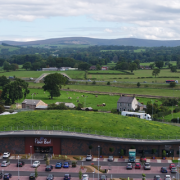

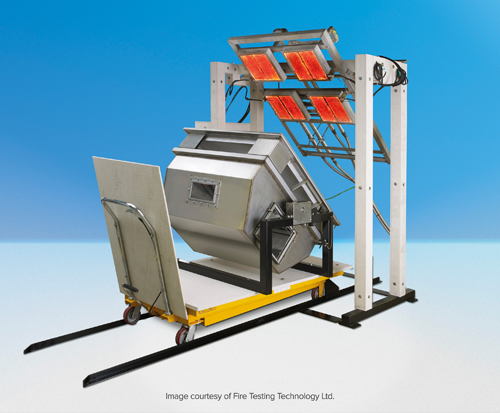 For a warm roof system, the typical build-up comprises an exposed membrane (the cap sheet/top layer), an optional underlay, thermal insulation, vapour control layer and structural deck. During testing, the exposed membranes must withstand flames and high radiant temperatures being applied to their surface for periods of time using parameters set out in CEN/TS1187:2012.
For a warm roof system, the typical build-up comprises an exposed membrane (the cap sheet/top layer), an optional underlay, thermal insulation, vapour control layer and structural deck. During testing, the exposed membranes must withstand flames and high radiant temperatures being applied to their surface for periods of time using parameters set out in CEN/TS1187:2012.
 After conducting detailed roof condition surveys across both sites, Langley advised that where practical the existing coverings could be overlaid, and a strip up to deck undertaken only where necessary, saving on site disruption, landfill costs and limiting carbon footprint.
After conducting detailed roof condition surveys across both sites, Langley advised that where practical the existing coverings could be overlaid, and a strip up to deck undertaken only where necessary, saving on site disruption, landfill costs and limiting carbon footprint.
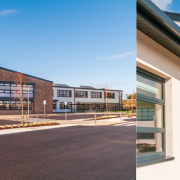
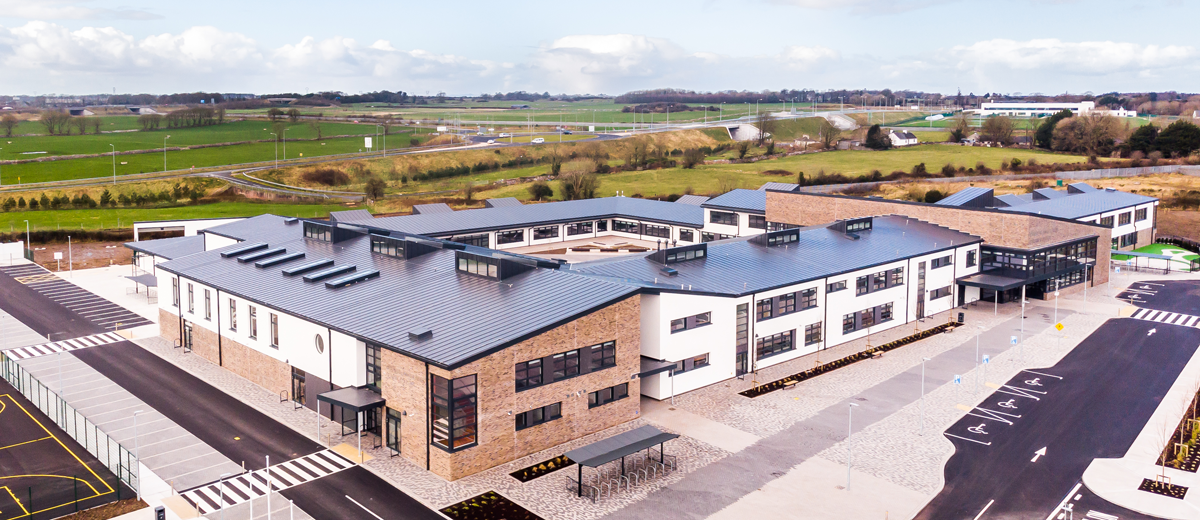
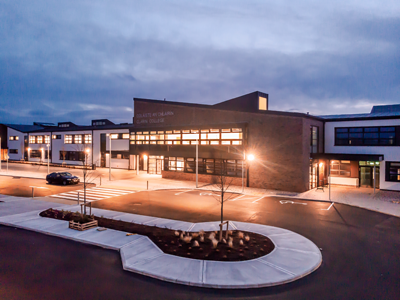 As a non-combustible insulation solution, ROCKWOOL HARDROCK® Multi-Fix Dual Density met the fire safety requirements while also delivering against the thermal and acoustic targets. Clarin College’s new flat roof achieved a U-value of 0.15 W/m2K, and met or exceeded the 35 db IANL requirement across both the general building and the gymnasium. To combat reverberation and improve the acoustic environment in the gymnasium, ROCKWOOL Acoustic Infills were laid in the troughs of the pre-finished steel deck. The warm flat roof build up was finished with a Bauder Thermofol PVC layer.
As a non-combustible insulation solution, ROCKWOOL HARDROCK® Multi-Fix Dual Density met the fire safety requirements while also delivering against the thermal and acoustic targets. Clarin College’s new flat roof achieved a U-value of 0.15 W/m2K, and met or exceeded the 35 db IANL requirement across both the general building and the gymnasium. To combat reverberation and improve the acoustic environment in the gymnasium, ROCKWOOL Acoustic Infills were laid in the troughs of the pre-finished steel deck. The warm flat roof build up was finished with a Bauder Thermofol PVC layer.


